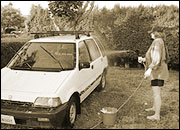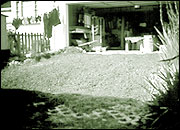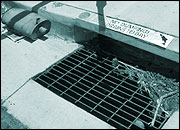| |
 |
| |
Renée Flower washes her car on the grass so the soapy, dirty water does not flow into the storm drain which empties into the Monterey Bay.

|
What have we done
to the rain? | by Renée Flower
When
rain falls on the Earth, raindrops land on plants and soil. Rainwater filters
through the soil slowly, providing moisture for plant roots and recharging the
groundwater. Plant roots help hold the soil in place and prevent erosion and mudslides.
When the soil is saturated and no more rain can be absorbed, water flows both
underground through the soil, and over ground, into rivers, streams, ponds, and
lakes. Impervious surfaces—such as roofs, roads, sidewalks, paved driveways,
parking lots, and many backyard patios—do not allow water to pass through
them to reach and soak into the soil below. A building is considered an impervious
surface because rain runs off the roof and does not reach the soil beneath the
building.
In urbanized areas, rainfall that once filtered slowly through the soil now washes quickly over constructed impervious surfaces and runs into street gutters and down storm drains. Most roads and parking lots are directly linked to the storm drain system, and nearly all the rain that falls on these surfaces becomes “urban runoff,” which eventually flows—either directly or via storm drains—into creeks, rivers, lakes, and the ocean.
 |
|
This driveway is constructed of turf block which allows rain to filter through to the soil below. The grass growing through the turf block provides a less harsh effect than concrete.
 |
|
When it rains, trash, litter, silt, automotive chemicals (oils and grease, antifreeze, and fine dust from tire wear), animal wastes, and many other contaminants, such as paint, detergents, fertilizers, and pesticides, are washed off land surfaces and into the storm drain system. Since storm drains are designed to carry only stormwater, most of these drains are not equipped with filters or cleaning systems and, consequently, deliver polluted urban runoff directly into rivers, streams, lakes, wetlands, and estuaries, and onto beaches and rocky shorelines. Many of the pollutants found in this runoff are toxic to fish, marine mammals, and other aquatic life.
Land development has two primary components: (1) buildings (shopping centers, houses, offices, gas stations, factories, etc.) and (2) transportation infrastructure (roads, driveways, and parking lots). Development transforms land in ways that increase the amount of impervious surface. The total impervious area created for the transportation component of land development often exceeds the area covered by buildings. For example, in some residential and commercial areas, over 60% of impervious surface is created specifically to support automobile use!
Polluted stormwater runoff related to imperviousness is a form of nonpoint source
pollution-it is called “nonpoint source” (NPS) because it does not originate
from an identifiable “point” or single source (such as an industrial
plant discharge pipe). NPS pollution is the leading cause of degraded water quality
in the United States and a significant cause of harmful impacts to the coastal
environment.
Coastal areas are more densely populated than other areas of the country. Half the U.S. population currently lives along our coasts, and these areas also are growing at faster rates. Approximately half of all new development occurs in coastal areas. As the coastal population grows, more impervious development is created to accommodate this growth. Studies show that when impervious land area exceeds just 10% of the total landscape, water quality and the health of urban streams starts to decline rapidly. One example of such decline is an increase in urban stream water temperatures which degrades the habitat for salmon and other fish.
| |
 |
| |
"NO
DUMPING, FLOWS TO BAY"

|
There is a clear link between major coastal water-quality problems and activities
along the shore. But, even inland from the ocean, water polluted with grease,
oil, and other contaminants can run off driveways, streets and parking lots into
storm drains and directly into a stream which eventually flows into the ocean.
Because polluted stormwater also contains bacteria and viruses, people who swim
in contaminated water can contract hepatitis, gastrointestinal disorders, or other
infections. For this reason, contamination from polluted runoff can result in
beach closures affecting activities such as swimming, scuba diving, and surfing.
How you can help
• Wash your car on a grassy area or at a commercial car wash.
Washing your car on your lawn (or at a carwash that directs its waste water into
the sanitary sewer system) is a better choice than washing it on your driveway
or on the street. By washing your vehicle on a grassy area or on pavement that
slopes toward an unpaved area where the water will be absorbed into the soil you
prevent soapy, oily, dirty water from flowing off your driveway and into the gutter
and storm drain.
• Dispose of soapy water in a sink.
After washing, pour the bucket of soapy water into a sink, not into the street
gutter or storm drain.
• Use small amounts of soap.
Even biodegradable soap is toxic to many types of animals and plants that live
in streams, rivers, lakes, and the ocean.
• Use pervious materials for new driveways and patios.
If you are constructing a new or replacement driveway or patio, consider using
pervious paving materials that allow water to soak into the soil. Alternative
pavers or porous pavements can replace conventional asphalt or concrete in parking
lots, driveways, and walkways in many cases. These materials provide more effective
protection of water quality than conventional asphalt or concrete because they
allow water to soak into the ground. Driveways can also be designed to direct
water into grassy areas where runoff will be absorbed by the soil and filtered
by plants and organisms that live in the soil.
• Take unwanted chemicals to hazardous waste collection centers.
Because soil cannot purify most chemicals, they may eventually contaminate runoff
if poured down storm drains or on the ground.
• Select landscaping plants that have low requirements for fertilizers,
pesticides, and water.
Also, do not apply fertilizers and pesticides before or during rain. These chemicals
could be washed into storm drains or nearby creeks.
• Support local measures designed to improve water quality, protect streams
and wetlands, and reduce non-point source pollution.
Many cities are working to address these problems, including the City of Santa
Cruz, which is currently reviewing a newly drafted “Citywide Creeks and Wetlands
Management Plan.” The plan presents strategies and proposes policies to minimize
impervious surfaces, control runoff into watercourses and wetlands, protect water
quality, and encourage restoration and enhancement of creek and wetland areas.
Please support this plan. To comment on this plan or for more information please
contact: Sandy Brown, Associate Planner, City of Santa Cruz, 420-5119.
• For more information visit
the following websites: Stormwater Manager’s Resource Center, www.stormwatercenter.net
Center for Watershed Protection, www.cwp.org.
[ top of page ]
|

